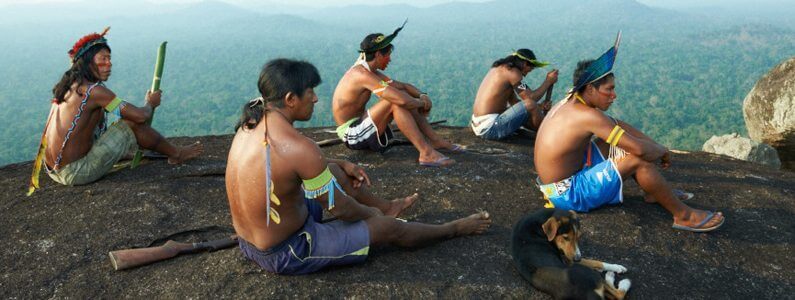
Conservation Significance of Kayapo Lands
Kayapo lands conserve the last remaining large, intact block of native forest in the southeastern Amazon, and maintain the connectivity of this ecoregion with the western Amazon. They confer incalculable benefits to protection of biodiversity, mitigation of climate change and preservation of the crucial role of Amazonian forests in producing rainfall over a much larger geographic scale.
Kayapo territories are large enough to protect large scale ecological processes. For example, very large areas are required to maintain tropical tree species because individuals of species are usually very sparsely distributed. Most tropical tree species depend on co-evolved animal vectors for pollination and seed dispersal across large inter-individual distances — small areas do not contain enough individuals or viable animal vector populations for regeneration of many forest tree species over the long term. The intricate web of interdependence among Amazonian species requires large areas for these ecosystems to function and persist.

The 110,000 km2 block of Kayapo lands is comprised of five contiguous ratified Indigenous Territories (TI): TI Kayapo, TI Bau, TI Menkragnoti, TI Capoto/Jarina, TI Badjonkore
Kayapo lands remain reasonably undisturbed. Large-bodied game species (including large cracids, lowland tapir, and white-lipped peccary), which are preferred by local peoples throughout the Amazon are abundant within the hunting range of Kayapo communities. Protected lands in the region safeguard a full complement of disturbance-sensitive wildlife and an entire vegetation transition from open savanna (cerrado) to close-canopy forests, along with endangered and threatened species (Table 1).
| Table 1: Threatened vertebrate species found in the Xingu protected areas corridor, with IUCN Red List designation. |
| Endangered species: bearded saki monkey (Chiropotes satanas utahicki) Critically Endangered giant otter (Pteronura brasiliensis) Endangered hyacinth macaw (Anodorhynchus hyacinthinus) Endangered white-whiskered spider monkey (Ateles marginatus) EndangeredNear Threatened or Vulnerable species: white-lipped peccary (Tayassu pecari) Near Threatened jaguar (Panthera onca) Near Threatened bush dog (Speothos venaticus) Near Threatened blue-winged macaw (Ara maracana) Near Threatened chestnut-throatedspinetail (Synallaxis cherriei) Near Threatened giant armadillo (Priodontes maximus) Vulnerable red-handed howler monkey (Alouatta belzebul epiphenotype discolor) Vulnerable neotropical otter (Lutra longicaudis) (decreasing; status to be determined) |
Kayapo lands and the contiguous Xingu Indigenous Park to the south protect more than four hundred kilometers of the Xingu river from degradation by deforestation, pollution and over-fishing. Preliminary surveys indicate that as many as 1,500 fish species inhabit the Xingu River. Fish are the most important source of protein for local people of the Xingu. Sixteen species of fish are considered endemic to (i.e. only found in) the Xingu.